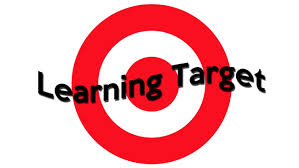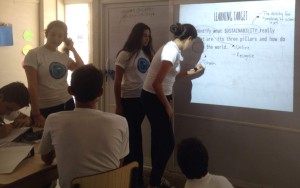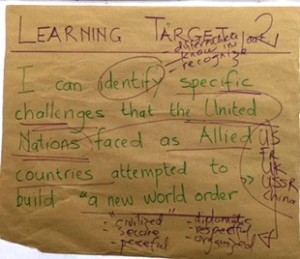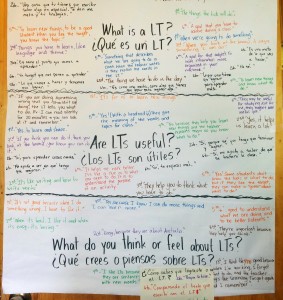The Learning Target Experiment Part 2

During the 2014-15 school year, we discovered the book Leaders of Their Own Learning by Ron Berger, Leah Rugen, and Libby Woodfin. Curious, we took it for a test drive and fell in love. This past September, we decided to begin implementing the book’s principles school-wide. We decided to take it slow, starting with the first chapter, which details learning targets, and then continue from there. Now, eight weeks later, as we look around the school, we’re impressed by the difference this one small change in teaching methodology has made. We’ve learned a lot – through both our successes and our failures.
We introduced learning targets to our teachers in our August professional development workshops. Teachers looked at the curricula they were covering, chose objectives, and began to write them as simple “I can…” statements. For example: “I can write a meaningful learning target.” Once they had learning targets in place, they planned to “unpack” them with their students (helping students define the verbs and nouns in the learning target by giving synonyms or clarifying phrases).
Using learning targets seemed fairly simple, and we didn’t foresee too many problems. But we were soon to discover that “simple” can be deceiving…
As we began to use the targets and observe one other, we realized it wasn’t as easy as we first imagined. For the next four weeks, during our Friday professional development workshops, we continued to focus on learning targets. After observing each other in each other’s classes, we reflected on our strengths and weaknesses and tried to improve our practice. Coaches worked closely with teachers throughout the week, helping them refine the work they were doing.
Here are some of the common mistakes we made and what we learned from them:
- Writing learning targets that were too long and involved. Often the teacher’s reaction later was “Oh! What was I thinking? How did I ever think we could unpack and cover this much information in one hour?” Many of our original learning targets had to be broken down into several smaller ones.
- Trying to cover too many learning targets in one class. It took us a while to realize that simpler is better, and that a learning target is truly a small goal that students can realistically aim to reach in one class period.
- Feeling that learning targets were too simple. In secondary school, teachers worried that the “I can…” statements would seem too babyish to their students and that their reaction would be negative (see student comments below to see just how wrong we were).
- Spending too much time on a learning target or rushing the unpacking. At first it was hard to get our timing right. Teachers either lingered over the learning target for a seemingly endless 15 minutes or more, or they covered them superficially in 30 seconds and students didn’t understand them. We finally realized that in about 3 – 5 minutes, we could thoroughly unpack a target while keeping students engaged.
- Tacking a learning target on as an afterthought rather than making it central to the lesson. At first it was hard for teachers to recognize the importance of the learning target. Sometimes they were written on the board but not unpacked or referred to at all. Once teachers heard the positive comments that students made about learning targets, they began to understand the importance of them and started using them more purposefully.
- Assuming students understand academic vocabulary like ‘analyze,’ ‘paraphrase,’ and ‘justify.’ We made the mistake of believing that students understand many of the terms we use with them every day. As we “unpacked” these words, we realized that most students only had a vague idea of what they meant. How can they meet a learning goal if they don’t know what’s expected of them? Unpacking academic language has helped most of our students improve their metacognitive skills and develop deeper understanding in all subject areas.
Wanting to know how they felt about learning targets, I began informally interviewing students from different grades. To my surprise, almost all the responses were positive. Only one student said, “I really don’t understand what the point is.” And another student pointed out that “…sometimes they’re too big. Teachers sometimes expect us to be able to learn too much in one class.” We used this feedback to help us correct some of the mistakes above.
Comments from students:
- “Our teacher puts a check mark beside the learning target when we’ve covered the material. At that point, you know that if you don’t understand it, you should get some extra help.” — 7th grade student
- “It’s clear what the teacher wants to achieve in the class. Without the learning targets, we used to do activities but we didn’t always understand why we were doing them.” — 8th grade student
- “Our teacher had us create our own learning target and that was great. We self-evaluated and then we decided what we wanted to learn. That makes what I’m learning feel a lot more important and I liked it.” — 8th grade student
- “Before, we didn’t really know what we were learning. We wondered ‘what’s the point of what she’s teaching?’ Now we know and it’s cool, because every single day you’re learning something different and you know what it is.” — 9th grade student
- “Learning targets make me feel more capable in school. I know what I’m supposed to be learning and it doesn’t seem that difficult, so I realize that I can be successful.” — 10th grade student
- “Learning targets make me feel like I’m in charge. I can assess what I know and make decisions about what I need to do to get better.” — 11th grade student
- “I like using learning targets, because we know what we have to learn but we also get to decide how we’re going to learn it, and we can study what we’re interested in. When we share information that interests us, our class discussions are so much better.” — 12th grade student
 But the best testimonial to how our students feel about learning targets came when our 9th graders were doing a science project in which they had to teach a lesson to the rest of the class. To our surprise, without any prompting, they used learning targets and unpacked them with their peers before beginning to teach their.lesson.
But the best testimonial to how our students feel about learning targets came when our 9th graders were doing a science project in which they had to teach a lesson to the rest of the class. To our surprise, without any prompting, they used learning targets and unpacked them with their peers before beginning to teach their.lesson.
Learning targets have helped our students take charge of their learning. What more could we ask for?!



Leave a comment